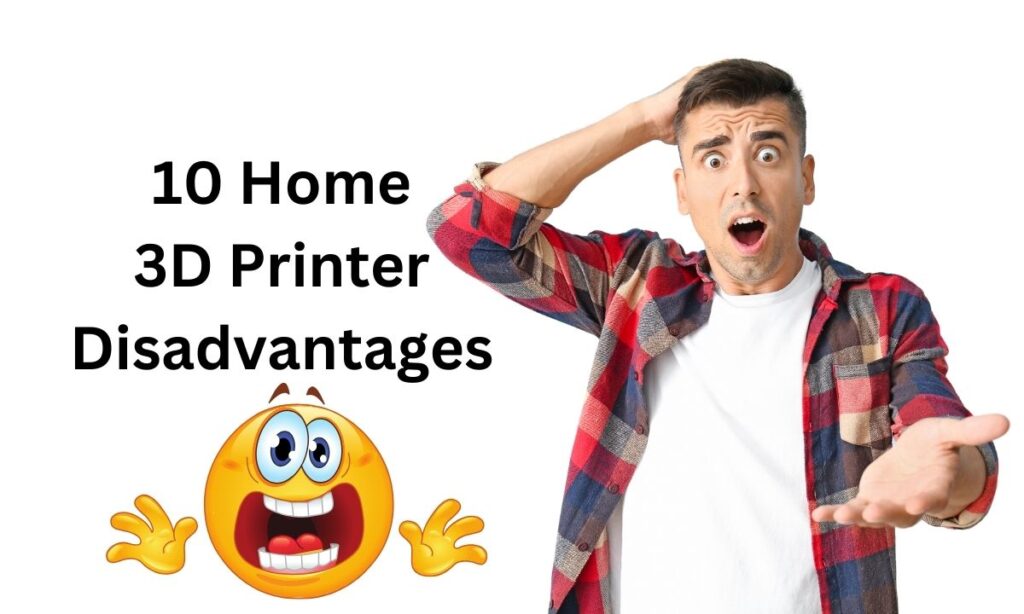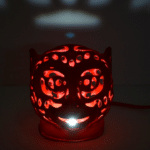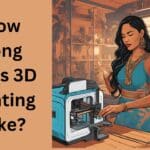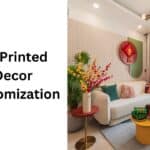
Home 3D printers offer creativity but come with high costs, safety risks, and limited uses—consider makerspaces or online services for access without the hassles.
Many individuals are intrigued by the idea of owning a 3D printer, drawn in by the potential to create custom objects and prototypes at home. However, before making such an investment, it’s crucial to consider the potential drawbacks. While there are plenty of good reasons for having a 3D printer, such as the ability to rapidly build almost any type of plastic part you might require, there are also several cases where it might not be advisable to buy your own 3D printer and operate it at home.
Affiliate Disclosure
We participate in Amazon affiliate programs, earning fees from qualifying purchases via links at no extra cost to you. It’s how we keep this blog rolling and my 3D printers buzzing with fresh filament for reviews like this one!
In this article, we will explore 10 Home 3D Printer Disadvantages you might want to think twice before purchasing one.
10 Home 3D Printer Disadvantages
1. Financial Considerations: Can You Afford It?
While there are inexpensive 3D printers available for around $200, these models often come with significant limitations. Lower-priced machines may require considerable tuning and modifications to work reliably. If you want a printer that performs well out of the box, you might need to invest in a more expensive model, which could be beyond your budget. Don’t buy a 3D printer unless you can afford the type of machine that meets your needs.
2. Project Longevity: Are You Committed Beyond One Creation?
Many people are excited about the prospect of 3D printing but may find themselves stalling after completing just one or two projects. The initial thrill can fade quickly if you run out of ideas for what to print. While online repositories like Thingiverse offer many designs, relying on them may lead you to justify your purchase without a genuine need or desire for ongoing projects. Don’t buy a 3D printer unless you have a clear plan for its long-term use.
3. Design Skills: Do You Know CAD?
While it’s easy to print pre-made models, many users eventually want to create their designs. However, learning how to use CAD (Computer-Aided Design) software can be a daunting task and may require a significant investment of time and money. If you don’t already know how to use CAD tools or aren’t willing to learn, purchasing a 3D printer might not be worth it. Don’t buy a 3D printer unless you have the intention of learning CAD or already possess the necessary skills.
4. Health and Safety: Is Your Workspace Ventilated?
Most 3D printers emit fumes and particles that can be harmful if inhaled over time. These emissions can include volatile organic compounds (VOCs) and undetectable nanoparticles that pose long-term health risks. If you don’t have a properly ventilated area for your printer, it may not be safe to operate at home. Don’t buy a 3D printer unless you have adequate ventilation or plan on setting up a suitable environment.
5. Noise Levels: Will It Disturb Others?
Many home 3D printers can be quite noisy, especially older models. The stepper motors and fans generate sounds that can echo throughout your home, potentially annoying others who aren’t as enthusiastic about 3D printing as you are. If noise is likely to disturb family members or roommates, consider whether you can keep the printer in a location where it won’t disrupt others. Don’t buy a 3D printer unless you’re sure it won’t disturb those around you.
| 3D Printer Model | Noise Level (dB) | Comments |
|---|---|---|
| Ender-7 | 53 | Part cooling fans |
| Ender-3 V2 NEO | 52.8 | Everything stock |
| Ender-3 V2 | 52 | Direct drive, but stock fans |
| Ender-5 S1 | 51 | Fast travel reaches 55 dB |
| Elegoo Neptune 3 PLUS | 51 | Double part cooling fans |
| Ender-2 Pro | 50.5 | |
| Sapphire Plus | 48.5 | Noise varies between 45-52 dB |
| Ender-5 Pro | 48 | |
| Ender-3 V2 + Enclosure | 47 | Uses Creality enclosure |
| Kingroon KP3S | 46.2 | |
| FLSUN SR | 46 | Retraction noise is loud |
| Ender-3 S1 | 45.2 | |
| Prusa MK3S | 45 | |
| BQ Hurakan | 45 | |
| Snapmaker A350T | 44.5 | Noise varies between 43-46 dB |
| Kywoo Tycoon | 44 | Not silent on Z-axis |
| Lotmaxx Shark V2 | 43.5 | Laser unit is quiet as well |
| Sermoon D1 | 42 | Not silent on Z-axis |
| Artillery SW X2 | 41.6 | |
| BIQU B1 SE Plus | 41 | |
| Mingda Magician X | 40.3 | Clicking noise during retraction |
| Artillery Genius Pro | 39 | Quietest in this test |
Note: "Not silent on Z" indicates the stepper motor driver on the Z-axis creates noisy movement.
6. Odor Management: Are You Prepared for Smells?
In addition to noise, many desktop 3D printers emit unpleasant odors during operation. While some materials produce more offensive smells than others, even commonly used filaments like PLA can create odors that may not be welcome in your home environment. If you’re sensitive to smells or have family members who are, this could be another reason to reconsider your purchase. Don’t buy a 3D printer unless you’re prepared for potential odors during printing.
7. Safety Risks: Do You Have Pets or Small Children?
Most desktop 3D printers have exposed moving parts and hot components, which can pose safety risks for small children and pets. An inquisitive child or pet could accidentally touch hot surfaces or get caught in moving parts, leading to injury or damage to the printer itself. If you cannot ensure that children or pets will remain safely away from the printer while it’s in use, it may be best not to purchase one at all. Don’t buy a 3D printer if you have small children or pets that cannot be secured from it.
8. Maintenance Mindset: Are You Handy with Repairs?
Unlike traditional household appliances that typically require little maintenance, desktop 3D printers can break down frequently and often need repairs or adjustments. If you’re not handy with tools or lack the inclination to troubleshoot technical issues, owning a 3D printer could become frustrating rather than enjoyable. Don’t buy a 3D printer unless you’re prepared to handle repairs and maintenance on your own.
9. Material Limitations: Will It Meet Your Needs?
While home 3D printers are versatile tools capable of creating various objects, they do have limitations regarding material options and applications. Many home printers primarily support plastic filaments like PLA and ABS; thus, they cannot produce items made from metal or other advanced materials used in industrial settings. If your projects require specific materials or durability standards beyond what home printers offer, investing in one might not meet your needs.
10. Exploring Alternatives: Are There Better Options Available?
Before committing to purchasing a home 3D printer, consider alternative options that might better suit your needs without the associated costs and challenges of ownership. Many local makerspaces provide access to high-quality printers for a fraction of the cost of ownership while also offering workshops and community support for beginners. Additionally, online services allow you to upload designs and have them printed and shipped directly to you without needing equipment at home.
Conclusion
While owning a home 3D printer can seem appealing due to its creative possibilities, it’s essential to weigh the potential drawbacks against your specific needs and circumstances carefully. From high initial costs and ongoing material expenses to safety concerns and limited applications, there are several reasons why purchasing a home 3D printer may not be the best decision for everyone.
If you’re still intrigued by the idea of creating custom objects at home but want to avoid these pitfalls, consider exploring local makerspaces or online printing services as alternatives that provide access to advanced technology without the challenges of ownership.
Ultimately, making an informed decision based on your unique situation is crucial before diving into the world of home 3D printing!













